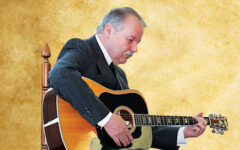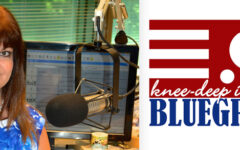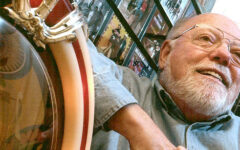
Pretty Good for a Girl is the rather grudging term often used in the past to damn with faint praise a female who is inclined to excel in some way.
Murphy Hicks Henry, the author, has the good humour to use this phrase as the title for her book subtitled, Women in Bluegrass.
Pretty Good for a Girl, to be published by the University of Illinois Press in June, is the first book devoted entirely to women in bluegrass music. It documents the lives of more than 70 women whose vibrant contributions to the development of bluegrass have been, for the most part, overlooked.
Very accessibly written and organized by decade, the book begins with Sally Ann Forrester, who played accordion and sang with Bill Monroe’s Blue Grass Boys from 1943 to 1946, and continues into the present with artists such as Alison Krauss, Rhonda Vincent and the Dixie Chicks.
Drawing from extensive interviews, well-known banjoist Murphy Hicks Henry gives voice to women performers and innovators throughout bluegrass’s history, including such pioneers as Bessie Lee Mauldin, Wilma Lee Cooper, and Roni and Donna Stoneman; family bands including the Lewises, Whites, and McLains; and later path-breaking performers such as the Buffalo Gals and other all-girl bands, Laurie Lewis, Lynn Morris, Missy Raines and many others.
Recently, Murphy and I were able to talk about some of the various aspects of the book and the work behind it ….
What prompted you to write the book?
Actually there was one incident that planted the seed. At the IBMA Awards Show in 1993, there was a group of young boys playing on stage, the Bluegrass Youth All-Stars, who were introduced, off the cuff, by one of the announcers as “the future of bluegrass music.”
Well, I was sitting in the audience with my teenage daughter Casey (who plays banjo and bass) and I was livid! Not that Casey had not been included, but that no young women had been included. In this day and age, I thought that oversight was unbelievable. When I was told that the organizers had looked for a young woman and couldn’t find one, I thought to myself, “This must never happen again,” so I started a database of women who played bluegrass.
The database eventually led me to start publishing a quarterly newsletter called Women in Bluegrass and that led to Judy McCulloh, an editor at the University of Illinois Press, suggesting that I write a book about women in bluegrass. And voila! Ten years later, here it is!
What were the biggest challenges that you faced along the way?
One of the biggest challenges was that there was so little information about these women available when I started writing about them. That meant I had to interview almost every woman who appears in the book. I loved doing the interviews and the women were wonderfully accessible, but that’s a lot of transcribing! Also, getting the facts “right” was very important to me. I got a bit obsessive about that and spent a lot of time digging out and verifying the details. Which meant I bought a lot of records, CDs and DVDs — great for verifying dates, song titles, album titles, and band personnel!
What were surprising revelations to you? Big discoveries?
The most surprising revelation to me was that there were so many women playing bluegrass early on. Especially so many female banjo players! I had thought I was pretty much “the only one.” (I heard that statement over and over in my interviews.) Then I realized that I had been guilty of “not seeing” the many women who were playing bluegrass when I came along. I had even written in the liner notes to my own banjo CD, M & M Blues (1992), that “Twenty years ago there were not many women in this bluegrass world, let alone women who played Scruggs-style banjo.” As I found out, that was patently untrue! I was astounded at my own blindness!
The format: is it like an encyclopedia?
No, no! It’s not like an encyclopedia! I want people to actually read the book! The format is more like a progressive narrative, with chapters for each woman. I start with Sally Ann Forrester, who played accordion with Bill Monroe from 1942-1946, and I move chronologically through the years, ending with the Dixie Chicks and Cherryholmes. By arranging the book this way, I hope readers can see how the musical accomplishments of earlier women paved the way for those who came after them. And how roles for women grew and expanded down through the years.
Does it include ladies from around the world?
Tackling the task of writing about the female bluegrass musicians in the United States was all I could handle! I make my apologies in the book’s introduction.
Did you form a special bond with some of the ‘subjects’ along the way? If so, which ladies do you love the most?
Many of the women I write about were already my friends when I started the book—Lynn Morris, Claire Lynch, Missy Raines, Betty Fisher, Lee Ann Lenker, Katie Laur, Margie Sullivan. Others were solid acquaintances whom I got to know better through working on the book and now count as friends: Laurie Lewis, Kathy Kallick, Beck Gentry, Mary Jo Leet, Suzanne Thomas, Kristin Scott Benson, Alice Gerrard, Gloria Belle, Martha Adcock. So, as you can see, it would be impossible to pick the ones I love the most!
However I have a special place in my heart for Sally Ann Forrester, the first women in the book, because she was the first woman I wrote about. I met her only one time, when she was in the advanced stages of Alzheimer’s in a nursing home in Nashville. Her son Bob took me to see her when I was writing my Master’s Thesis about her life. I’ll never forget him bending down to her bed and gently saying to her, “Mama, here’s your Boswell.” (Referring to James Boswell who wrote the biography, The Life of Samuel Johnson.)
Sally Ann had been so neglected by the bluegrass community because she played the accordion, because she was a woman, and because people thought she was only in the band because her husband Howdy played the fiddle with the group. I am glad to clear all that up!
Some further insight is provided by this video featuring the author …..
Pretty Good for a Girl
528 pages, 66 black & white photographs
Paper 978-0-252-07917-7 – $29.95
Cloth 978-0-252-03286-8 – $90.00
The cloth edition is unjacketed.
Murphy Hicks Henry is a professional banjo player, teacher, and writer living in Virginia. She founded the Women in Bluegrass newsletter and has written regularly for Bluegrass Unlimited and Banjo Newsletter. She is also the co-creator of The Murphy Method, a series of instructional videos on playing the banjo and other bluegrass instruments.







